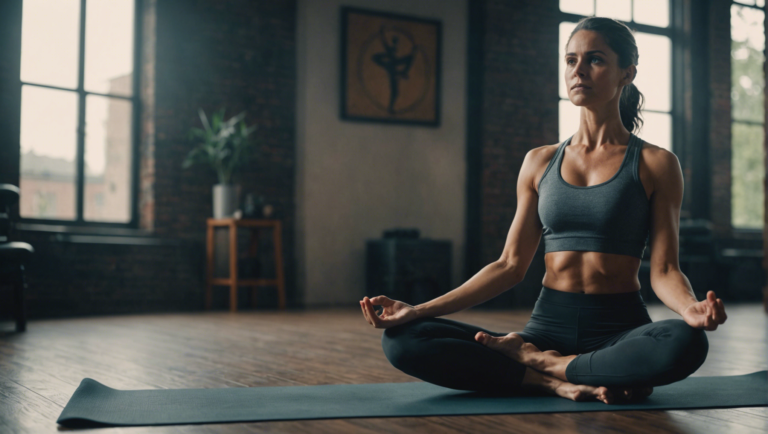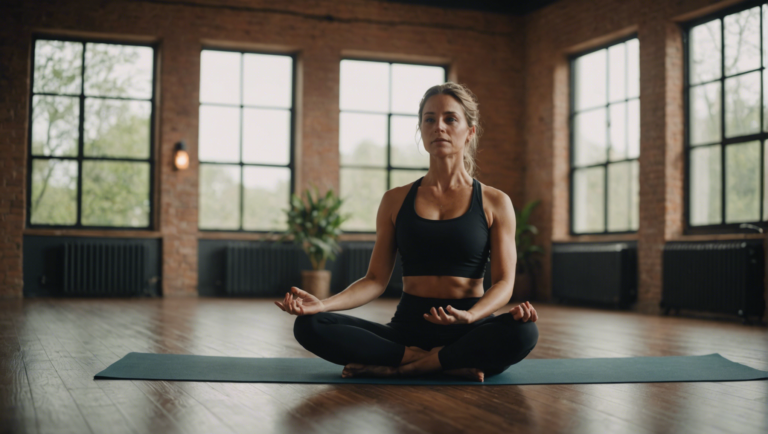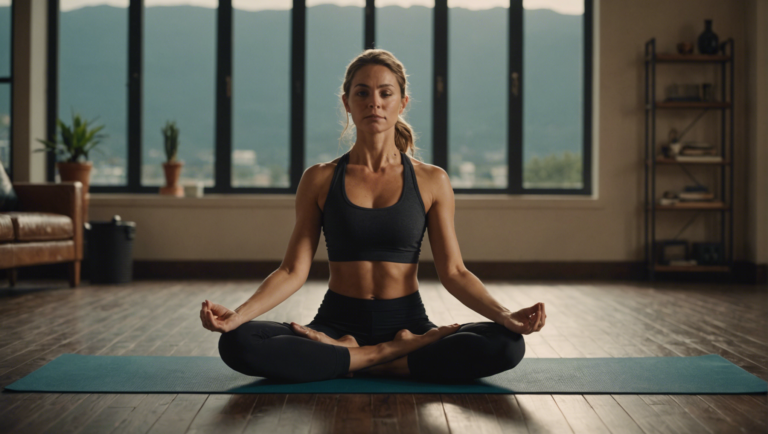Guidelines For Understanding The Standard Yoga Mat Size
The Importance of Standard Yoga Mat Size in Practice
Standard Yoga Mat: An Integral Element for Practice Optimization
Importance of Using the Right Size Yoga Mat
Yoga is a practice that combines physical postures, breathing techniques, and meditation to enhance overall well-being. One essential element of a successful yoga practice is the yoga mat. The standard size of a yoga mat plays a crucial role in ensuring a comfortable and safe practice.
Optimal Dimensions of a Standard Yoga Mat
The standard size for a yoga mat is typically 68 inches long and 24 inches wide. This size provides ample space for practitioners of all shapes and sizes to comfortably execute various yoga poses without feeling cramped or restricted. The thickness of a standard yoga mat can vary, with most mats falling between 1/8 to 1/4 inch in thickness. The thickness of the mat also contributes to the comfort and stability it offers during practice.
Why Size Matters in Yoga Practice
Using a yoga mat that is too small can hinder your practice by limiting your range of motion and causing discomfort during poses. A mat that is too large, on the other hand, can be cumbersome and challenging to move on, making it difficult to maintain balance and stability in certain poses. By using a standard-sized yoga mat, practitioners can ensure they have enough space to move freely while still feeling supported and grounded during their practice.
Enhanced Alignment and Stability
The standard size of a yoga mat is designed to provide practitioners with the ideal foundation for proper alignment and stability during practice. A mat that is too small may not fully support your body in certain poses, while a mat that is too large can make it challenging to gauge where to place your hands and feet for optimal alignment. With the standard dimensions of a yoga mat, practitioners can easily align their body and feel secure in their poses, enhancing the overall effectiveness of their practice.
Comfort and Focus
Practicing yoga on a mat that is the right size allows for greater comfort and focus during your practice. A standard-sized mat offers enough cushioning to protect your joints and bones while also providing a stable surface for standing, balancing, and seated poses. The comfort provided by a correctly sized yoga mat enables practitioners to focus their attention inward, fostering a deeper mind-body connection throughout their practice.
The standard size of a yoga mat is a critical aspect of a successful yoga practice. By using a mat that is the right size, practitioners can enhance their alignment, stability, comfort, and focus during their practice, ultimately leading to a more rewarding and fulfilling yoga experience. Investing in a standard-sized yoga mat is a simple yet significant step towards optimizing your yoga practice and achieving your wellness goals.
Factors to Consider When Choosing the Right Yoga Mat Size
Yoga mats are an essential accessory for practicing yoga, providing comfort, stability, and support during various poses and exercises. Choosing the right size of yoga mat is crucial to ensure a pleasant and effective yoga practice. Several factors come into play when determining the ideal yoga mat size for your needs.
When selecting a yoga mat size, it’s essential to consider your height and body size. The standard yoga mat size is 68 inches long and 24 inches wide. However, taller individuals may require a longer mat to accommodate their height fully. A longer mat provides extra room to stretch out comfortably during practice, preventing hands or feet from extending beyond the mat’s edges.
Another factor to consider is the type of yoga you practice. For dynamic styles such as Ashtanga or Vinyasa, a larger mat allows for more movement and space to flow between poses seamlessly. On the other hand, if you primarily practice restorative or Yin yoga, a standard-sized mat may be sufficient as these styles involve more stationary and relaxed poses.
The thickness of the yoga mat also plays a role in choosing the right size. Thicker mats provide more cushioning and support for sensitive joints, making them ideal for individuals with injuries or those seeking extra comfort during their practice. Keep in mind that the thickness of the mat can affect its weight and portability, so consider your needs and preferences accordingly.
Additionally, consider where you will be practicing yoga. If you attend classes at a studio, a standard-sized mat is typically suitable as most studios provide enough space between mats for practitioners. However, if you prefer practicing at home or in outdoor settings, you may opt for a larger mat to ensure you have ample space for movement without restrictions.
It’s also worth noting that the texture of the mat can impact your practice. Some practitioners prefer a grippy texture to prevent slipping during poses, while others may prioritize a softer, more cushioned surface. Regardless of the texture, ensure that the mat size accommodates your preferred yoga styles and comfort levels.
When choosing a yoga mat size, remember to consider your storage space as well. Larger mats require more storage room, so assess whether you have adequate space at home or if you need a mat that can be easily rolled up and stored when not in use.
Selecting the right yoga mat size involves considering your height, body size, yoga style, mat thickness, practice environment, texture preferences, and storage space. By evaluating these factors, you can choose a yoga mat size that enhances your practice and overall yoga experience.
Understanding the Dimensions of a Standard Yoga Mat
Yoga has gained immense popularity in recent years for its numerous physical and mental health benefits. When practicing yoga, having the right equipment is essential to ensure a comfortable and effective session. One key piece of equipment that every yogi should have is a yoga mat. Understanding the standard dimensions of a yoga mat is crucial in choosing the right one for your practice. Let’s delve into the guidelines for understanding the standard yoga mat size.
Importance of Yoga Mat Dimensions
The dimensions of a yoga mat play a significant role in providing stability, comfort, and support during yoga practice. A standard yoga mat’s size can vary slightly depending on the brand, but there are general guidelines to help you understand the dimensions.
Standard Yoga Mat Size
The standard size of a yoga mat is approximately 68 inches long and 24 inches wide. This size is suitable for most practitioners, providing enough space to move freely while also ensuring that you stay on the mat during various poses. However, taller individuals may require a longer mat to accommodate their height comfortably.
Thickness of the Yoga Mat
In addition to length and width, the thickness of a yoga mat is also an important factor to consider. Standard yoga mats typically have a thickness of about 1/8 inch, providing adequate cushioning for joint support and comfort. Thicker mats, usually around 1/4 inch, offer more cushioning, which can be beneficial for practitioners with sensitive joints.
Oversized Yoga Mats
For practitioners who prefer extra room to move around or have a larger frame, oversized yoga mats are available. These mats can be around 72 inches long and 30 inches wide, providing additional space without compromising on comfort and support. Oversized mats are particularly suitable for taller individuals or those who simply prefer more room during their practice.
Travel-Friendly Yoga Mats
On the other end of the spectrum are travel-friendly yoga mats, which are designed to be lightweight and compact for easy transport. These mats are typically thinner than standard mats, making them easier to fold or roll up to fit into a suitcase or carry-on bag. While travel mats may sacrifice some cushioning for portability, they are ideal for yogis on the go.
Consider Your Practice
When selecting a yoga mat, consider the type of yoga you practice. For more dynamic practices like vinyasa or power yoga, a sticky mat with good traction is essential to prevent slipping. If you practice gentle or restorative yoga, a thicker mat for extra comfort during longer holds may be more suitable.
Understanding the dimensions of a standard yoga mat is crucial for choosing the right mat that suits your body and practice. Whether you opt for a standard-sized mat, an oversized mat, or a travel-friendly mat, ensure that it offers the comfort, support, and stability you need to enhance your yoga practice. By considering the dimensions and thickness of the mat, you can create a perfect foundation for a fulfilling yoga experience.
Customizing Your Yoga Practice with Different Mat Sizes
Yoga practitioners come in all shapes and sizes, and the standard yoga mat size may not always cater to everyone’s needs. Customizing your yoga practice with different mat sizes can significantly enhance your overall experience on the mat. Whether you’re taller, shorter, or simply prefer more space to move around, choosing the right yoga mat size can make a world of difference in your practice.
Benefits of Using the Right Size Yoga Mat
Selecting a yoga mat that suits your body dimensions can improve your alignment and prevent injuries during your practice. A larger mat provides more room for movement and allows you to fully stretch out without worrying about slipping off the mat. On the other hand, a smaller mat might be more portable and convenient for travel or smaller practice spaces.
Understanding the Standard Yoga Mat Size
The standard yoga mat size is typically around 68 inches long and 24 inches wide, with a thickness ranging from 1/16 inch to 1/4 inch. While this size works well for many practitioners, taller individuals or those looking for extra space may benefit from a longer or wider mat. Some companies offer longer mats (e.g., 72 inches or more) to accommodate taller yogis, while others provide wider mats for added comfort during poses.
Factors to Consider When Choosing a Yoga Mat Size
When customizing your yoga practice with different mat sizes, several factors should influence your decision:
- Height: Taller individuals may require a longer mat to comfortably fit their entire body during asanas.
- Width: Practitioners who prefer more space for movement or have broader shoulders may opt for a wider mat.
- Portability: Smaller mats are easier to carry around, making them ideal for travel or outdoor practice.
- Practice Space: Consider the dimensions of your practice area to ensure your mat fits comfortably within the available space.
Tips for Finding the Right Yoga Mat Size
To determine the best yoga mat size for your practice, consider the following tips:
- Measure Your Body: Take your height and width into account when choosing a mat size that provides ample space for movement.
- Try Before You Buy: If possible, test out different mat sizes at a yoga studio or store to see which dimensions feel most comfortable for your practice.
- Read Reviews: Research online reviews to gather insights from other practitioners who have tried different mat sizes.
- Consult with Instructors: Seek guidance from yoga instructors or experienced practitioners who can recommend the best mat size based on your body type and practice style.
Customizing Your Yoga Practice
By customizing your yoga practice with different mat sizes, you can tailor your experience to suit your unique needs and preferences. Whether you prioritize comfort, portability, or space for movement, selecting the right yoga mat size can optimize your practice and enhance your overall well-being on and off the mat.
Remember, yoga is a personal journey, and choosing the right mat size is just one way to make your practice more enjoyable and fulfilling. Experiment with different sizes, listen to your body’s feedback, and embrace the opportunity to customize your yoga experience to align with your individual requirements.
Tips for Maintaining and Cleaning Your Yoga Mat
Maintaining and Cleaning Your Yoga Mat
Yoga mats are essential for any yoga practice, providing cushioning and traction for a safe and comfortable workout. To ensure the longevity and hygiene of your yoga mat, regular cleaning and maintenance are crucial. Here are some tips to help you keep your yoga mat in top condition.
Importance of Regular Cleaning
Regularly cleaning your yoga mat is not only important for hygiene but also for maintaining its quality. During your yoga practice, your mat absorbs sweat, dirt, and bacteria, making it necessary to clean it after each use. A clean mat not only prevents the build-up of odor-causing bacteria but also extends the lifespan of your mat.
Daily Maintenance Routine
After each yoga session, take a few minutes to give your yoga mat a quick wipe down. Use a yoga mat spray or a mixture of water and mild detergent to clean the surface of the mat. Wipe it down with a clean cloth or towel to remove any sweat or dirt. Make sure to air dry your mat before rolling it up to prevent moisture from getting trapped and causing mildew.
Deep Cleaning
In addition to daily maintenance, it is essential to deep clean your yoga mat regularly. Depending on how often you use your mat, aim to deep clean it at least once a month. You can deep clean your mat by submerging it in a bathtub filled with warm water and a gentle detergent. Gently scrub the mat with a soft brush or cloth to remove any deep-seated dirt or stains. Rinse the mat thoroughly and hang it to air dry completely before rolling it up.
Sun-Drying Your Yoga Mat
Sunlight is a natural disinfectant and can help freshen up your yoga mat. After cleaning your mat, hang it outside in direct sunlight to dry. The ultraviolet rays from the sun will help kill any remaining bacteria on the mat. Just make sure not to leave your mat out in the sun for too long, as overexposure to sunlight can cause your mat to deteriorate.
Storage Tips
Proper storage can also help extend the life of your yoga mat. When not in use, roll up your mat loosely with the top side (the side you practice on) facing outwards. Avoid storing your mat in damp or dark places, as this can promote the growth of mold and mildew. Invest in a yoga mat bag or carrier to protect your mat from dust and dirt when not in use.
By following these tips for maintaining and cleaning your yoga mat, you can ensure that your mat remains fresh, hygienic, and in good condition for years to come. A clean and well-maintained yoga mat not only enhances your practice but also contributes to a healthier yoga experience overall. Incorporate these simple cleaning and maintenance practices into your routine to get the most out of your yoga mat.
Conclusion
As you delve into the world of yoga practice, the importance of the standard yoga mat size becomes increasingly evident. The right dimensions can significantly impact your comfort, stability, and overall experience during your practice sessions. Whether you are a beginner or a seasoned yogi, understanding the significance of selecting the correct yoga mat size is crucial for maximizing the benefits of your practice.
When choosing the right yoga mat size, several key factors come into play. Your height, the type of yoga you practice, and your personal preferences all play a role in determining the ideal dimensions for your mat. By considering these aspects thoughtfully, you can ensure that your yoga mat provides the necessary support and comfort for your practice.
To better understand the dimensions of a standard yoga mat, it is essential to grasp the typical measurements used in the industry. A standard yoga mat is usually around 68 inches long and 24 inches wide, providing ample space for most practitioners. However, variations in thickness and material can also influence the overall feel and performance of the mat.
Customizing your yoga practice with different mat sizes offers a versatile approach to your routines. For instance, a larger mat may be beneficial for dynamic practices that involve more movement and space, while a smaller mat could be ideal for travel or more focused practices. Experimenting with various sizes can help you discover what works best for your unique needs and preferences.
Maintaining and cleaning your yoga mat is essential for its longevity and hygiene. Regular cleaning with a gentle solution of water and mild soap can help remove sweat, dirt, and bacteria. Additionally, allowing your mat to air dry properly after each use can prevent moisture buildup and odors, ensuring a fresh surface for your next practice session.
As you navigate the world of yoga mats and their dimensions, remember that the right size can enhance your overall practice experience. By considering factors such as your height, practice style, and personal preferences, you can select a mat that meets your specific needs. Customizing your practice with different mat sizes offers versatility and adaptability to suit various routines. Moreover, maintaining proper hygiene and cleaning practices can prolong the life of your mat while ensuring a clean and safe surface for your yoga sessions.
The standard yoga mat size plays a significant role in optimizing your yoga practice. By understanding the importance of choosing the right dimensions, considering key factors in selection, and exploring customization options, you can enhance your practice experience. With proper maintenance and cleaning routines, your yoga mat can remain a reliable companion on your wellness journey, providing the support and comfort you need to cultivate mindfulness and strength on the mat.


